South America Electric Vehicle Battery Manufacturing Market Size
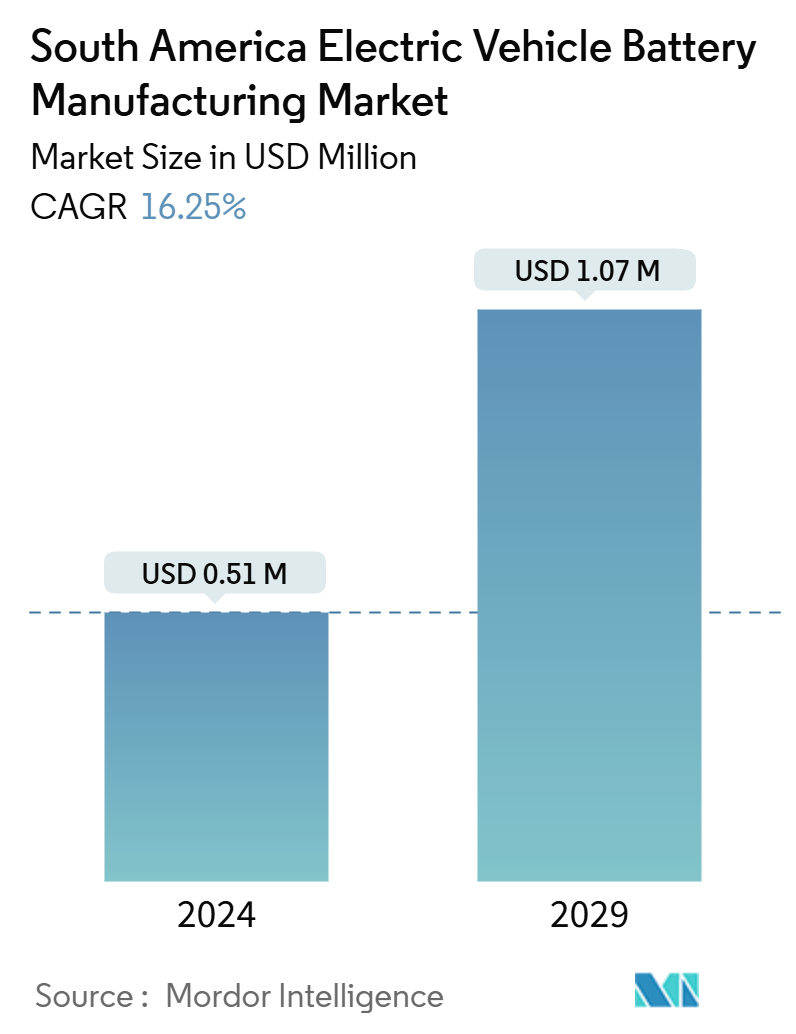
| Study Period | 2019 - 2029 |
| Base Year For Estimation | 2023 |
| Market Size (2024) | USD 0.51 Million |
| Market Size (2029) | USD 1.07 Million |
| CAGR (2024 - 2029) | 16.25 % |
| Market Concentration | High |
Major Players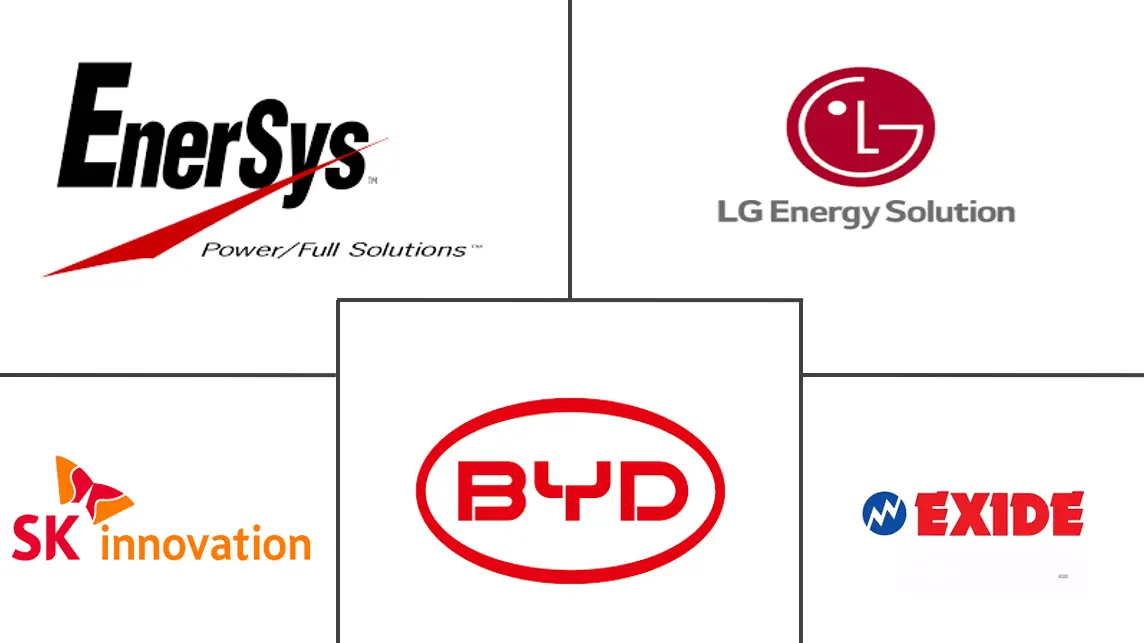
*Disclaimer: Major Players sorted in no particular order |
South America Electric Vehicle Battery Manufacturing Market Analysis
The South America Electric Vehicle Battery Manufacturing Market size is estimated at USD 0.51 million in 2024, and is expected to reach USD 1.07 million by 2029, at a CAGR of 16.25% during the forecast period (2024-2029).
- Over the medium term, factors such as the increasing adoption of electric vehicles in the region coupled with the abundance of raw materials in the region are expected to be among the most significant drivers for the South American electric Vehicle Battery Manufacturing Market during the forecast period.
- On the other hand, established battery markets such as Asia Pacific are competing. This poses a threat to the South American electric Vehicle Battery Manufacturing Market during the forecast period.
- Nevertheless, continued efforts to create collaborations and partnerships between South American countries are expected to create several opportunities for the market in the future.
- Brazil is expected to dominate the market and will likely register the highest growth during the forecast period due to the government's rising efforts to establish battery manufacturing and the growing adoption of electric vehicles.
South America Electric Vehicle Battery Manufacturing Market Trends
Lithium-ion Battery to Witness Significant Growth
- The lithium-ion battery segment is a cornerstone of the electric vehicle (EV) battery manufacturing market in South America, driven by the region's abundant natural resources, evolving industrial capabilities, and increasing commitment to sustainability. South America is home to the "Lithium Triangle," encompassing Brazil, Chile, and Argentina, which collectively hold over a significant share of the world's known lithium reserves.
- For instance, the Energy Institute Statistical Review of World Energy reported that South America's lithium reserves exceeded 71.03 thousand tonnes of lithium content in 2023. This marked a substantial growth of 22.82% from 2022, positioning it as one of the fastest-growing regions globally. Notably, from 2018 to 2023, South America boasted an impressive annual average growth rate of over 38.1%, underscoring the region's escalating lithium reserves and production capacity.
- This strategic advantage positions the region as a vital player in the global supply chain for lithium-ion batteries, which are pivotal in powering electric vehicles due to their high energy density, long cycle life, and relatively low self-discharge rates. The extraction and processing of lithium have become increasingly sophisticated, with South American countries investing in technology to improve extraction efficiency and environmental sustainability. Despite challenges such as water usage and the environmental impact of mining operations, advancements in green mining techniques are being explored to mitigate these issues.
- In May 2024, Rio Tinto, Eramet, and LG Energy proposed an innovative approach in Chile's Salares Altoandinos: a new lithium extraction technology. This initiative goes beyond mere production increases; it aims to redefine lithium mining's environmental impact, establishing pioneering sustainability benchmarks.
- Known as Direct Lithium Extraction (DLE), this method marks a notable leap from conventional practices. Unlike the slow and landscape-dominating evaporation ponds typical in South America's lithium-rich areas, DLE methods employ chemical, physical, or electrical processes to extract lithium from brine. This not only enhances efficiency but also minimizes environmental disturbances.
- Similarly, in Brazil, initiatives are underway to develop a comprehensive battery manufacturing ecosystem that includes not only raw material extraction but also the production of battery cells and recycling facilities, thus creating a circular economy around battery use. Argentina, with its significant lithium reserves, is also focusing on attracting foreign investment to establish local battery manufacturing facilities, aiming to move beyond raw material exportation to value-added production.
- Given these developments, the lithium-ion battery sector is poised for significant growth in the coming years.
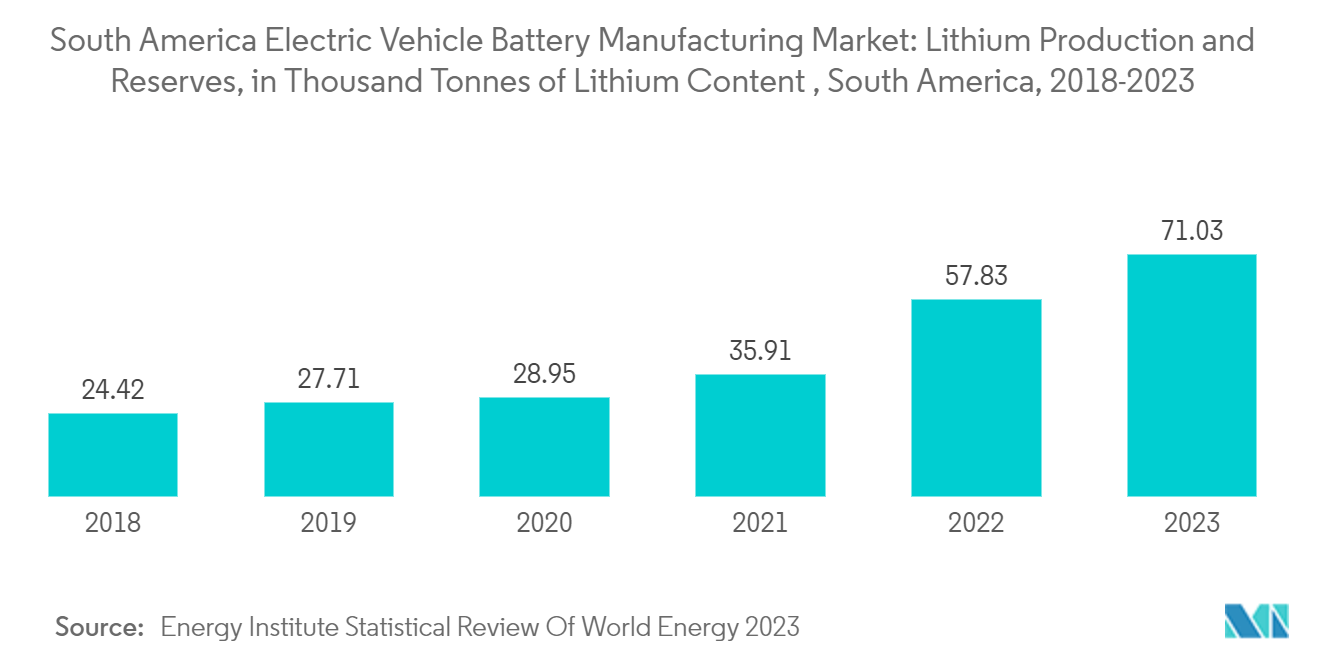
Brazil to Dominate the Market
- Brazil is poised to dominate the South American electric vehicle (EV) battery manufacturing market due to a confluence of strategic, economic, and technological factors that favor its development as a regional powerhouse in this burgeoning sector. As the largest economy in South America, Brazil offers a robust industrial base and a well-established automotive industry, which collectively provide a solid foundation for expanding into electric vehicle battery manufacturing.
- Brazil's extensive natural resources, particularly minerals such as nickel, cobalt, and lithium, are crucial for lithium-ion battery production and offer significant potential for domestic sourcing of critical raw materials. Brazil's geographical location and developed infrastructure further enhance its potential as a logistical hub for both import and export within the continent, facilitating the efficient movement of goods and fostering international trade relationships.
- In addition, Brazil's government has demonstrated a solid commitment to transitioning toward sustainable energy solutions and reducing carbon emissions, aligning with global trends and reinforcing the domestic market's growth prospects for electric vehicle sales and related battery technologies.
- According to the International Energy Agency, Brazil witnessed a surge in electric vehicle sales in 2023, reaching 19,000 units. This marked a notable 123.5% increase from 2022. Impressively, over the last five years, sales have skyrocketed, growing by over 100 times, underscoring the escalating demand for electric vehicles in the nation.
- The Brazilian government is actively promoting policies to incentivize the development of renewable energy and the adoption of electric vehicles, which in turn is stimulating demand for locally manufactured batteries. Initiatives such as tax breaks, subsidies, and investment in research and development are designed to attract both domestic and foreign investment into the battery manufacturing sector. These policy measures are complemented by partnerships with international technology firms, which are eager to leverage Brazil's vast market potential and skilled labor force.
- For instance, in July 2023, BYD is planning to build three production facilities on a former Ford industrial site in Brazil: one for the production of electric and hybrid cars, one for chassis for electric buses and trucks, and a third that will process lithium and iron phosphate for the electric vehicle battery market. To convert the site in the Camaçari industrial park in the Brazilian state of Bahia, BYD is ready to spend up to USD 617 million.
- Thus, such a scenario is expected to Brazil the dominating player in the market during the forecast period.
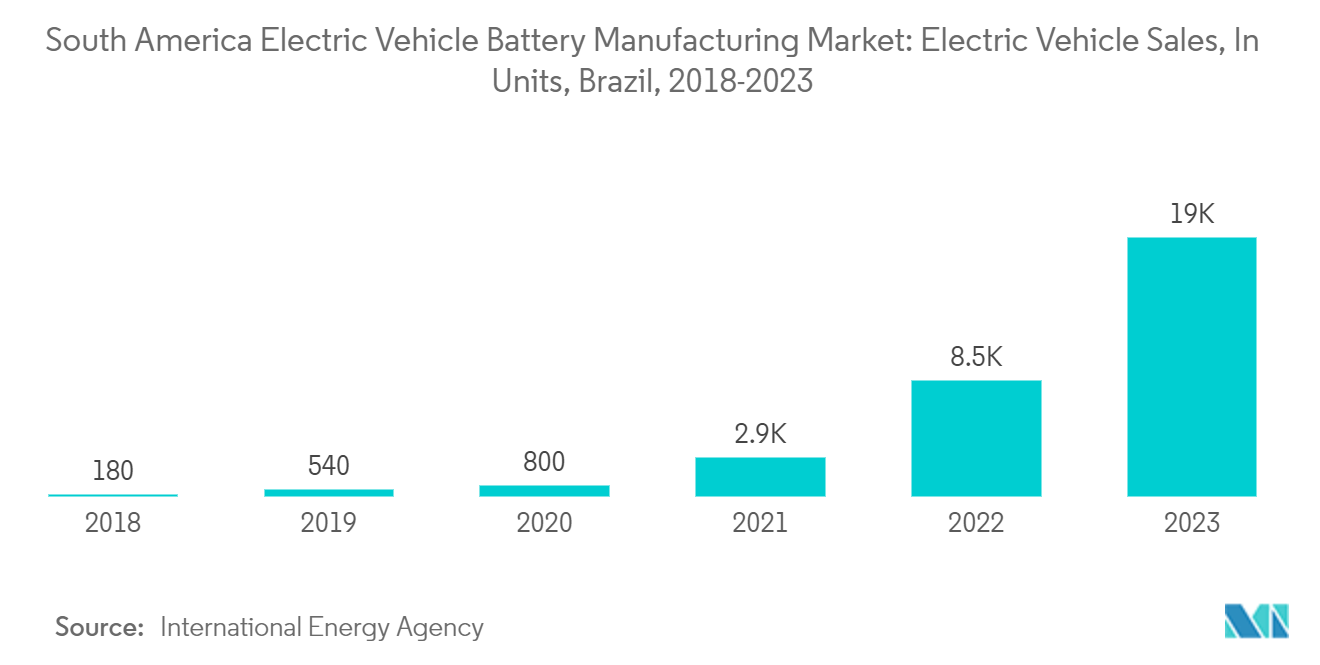
South America Electric Vehicle Battery Manufacturing Industry Overview
The South America Electric Vehicle Battery Manufacturing Market is semi-consolidated. Some of the key players in this market (in no particular order) are BYD Co. Ltd, SK innovation Co., Ltd., EnerSys, LG Chem Ltd, and Exide Industries.
South America Electric Vehicle Battery Manufacturing Market Leaders
-
BYD Co. Ltd
-
SK innovation Co., Ltd.
-
EnerSys
-
LG Chem Ltd
-
Exide Industries
*Disclaimer: Major Players sorted in no particular order
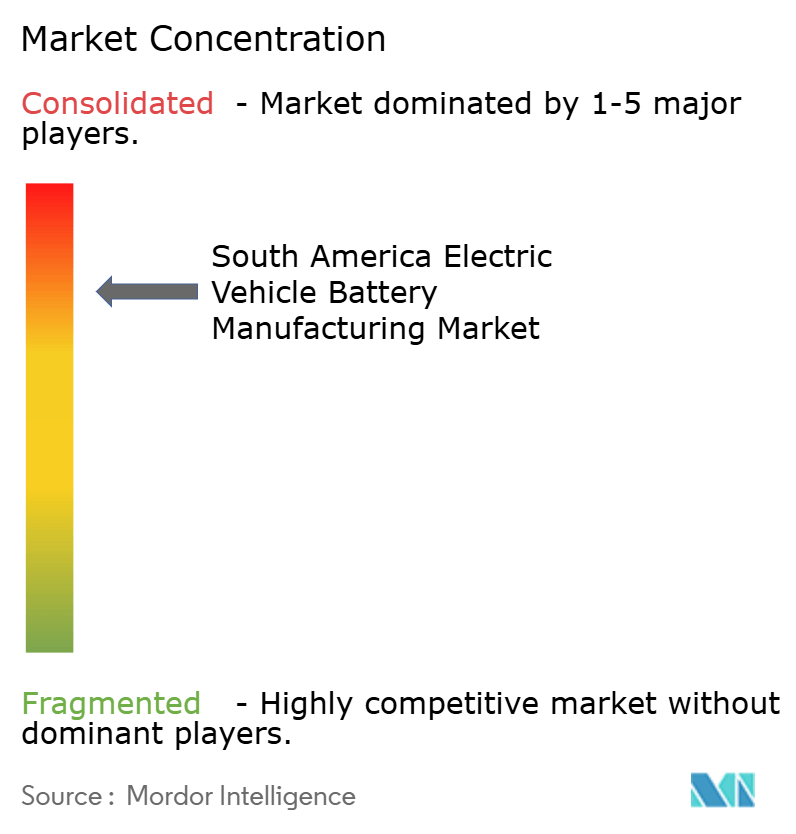
South America Electric Vehicle Battery Manufacturing Market News
- June 2024: Chilean lithium giant SQM, the world's second-largest producer, announced a significant long-term agreement with Hyundai and Kia. The deal secures a steady supply of lithium, a crucial component in electric vehicle battery production. SQM's current annual capacity for lithium hydroxide, derived from lithium carbonate, stands at 40,000 metric tons, as per its Q1 results. The company is targeting a substantial increase, aiming to hit 100,000 tons by 2025 in Chile, while also expanding operations in China and Australia.
- May 2024: Eramine Sudamerica, a venture backed by French miner Eramet and Chinese firm Tsingshan, is readying to open its inaugural lithium carbonate plant in Salta, Argentina. This move positions the company as the fourth major lithium producer in Argentina, a key player in the electric vehicle battery supply chain. Eramine Sudamerica anticipates an initial output of 3,000 tons this year, with ambitious plans to scale up to 24,000 tons by 2025.
South America Electric Vehicle Battery Manufacturing Market Report - Table of Contents
1. INTRODUCTION
1.1 Scope of the Study
1.2 Market Definition
1.3 Study Assumptions
2. EXECUTIVE SUMMARY
3. RESEARCH METHODOLOGY
4. MARKET OVERVIEW
4.1 Introduction
4.2 Market Size and Demand Forecast in USD, till 2029
4.3 Recent Trends and Developments
4.4 Government Policies and Regulations
4.5 Market Dynamics
4.5.1 Drivers
4.5.1.1 Increasing Adoption of Electric Vehicles
4.5.1.2 Abundance of Raw Materials
4.5.2 Restraints
4.5.2.1 Competition From Established Markets
4.6 Supply Chain Analysis
4.7 Industry Attractiveness - Porter's Five Forces Analysis
4.7.1 Bargaining Power of Suppliers
4.7.2 Bargaining Power of Consumers
4.7.3 Threat of New Entrants
4.7.4 Threat of Substitutes Products and Services
4.7.5 Intensity of Competitive Rivalry
4.8 Investment Analysis
5. MARKET SEGMENTATION
5.1 Battery
5.1.1 Lithium-ion
5.1.2 Lead-Acid
5.1.3 Nickel Metal Hydride Battery
5.1.4 Others
5.2 Battery Form
5.2.1 Prismatic
5.2.2 Pouch
5.2.3 Cylindrical
5.3 Vehicle
5.3.1 Passenger Cars
5.3.2 Commercial Vehicles
5.3.3 Others
5.4 Propulsion
5.4.1 Battery Electric Vehicle
5.4.2 Hybrid Electric Vehicle
5.4.3 Plug-in Hybrid Electric Vehicle
5.5 Geography
5.5.1 Brazil
5.5.2 Argentina
5.5.3 Colombia
5.5.4 Rest of South America
6. COMPETITIVE LANDSCAPE
6.1 Mergers and Acquisitions, Joint Ventures, Collaborations, and Agreements
6.2 Strategies Adopted by Leading Players
6.3 Company Profiles
6.3.1 BYD Co. Ltd
6.3.2 SK innovation Co., Ltd.
6.3.3 EnerSys
6.3.4 LG Chem Ltd
6.3.5 Exide Industries
6.3.6 Panasonic Corporation
- *List Not Exhaustive
6.4 List of Other Prominent Companies
6.5 Market Ranking/Share (%) Analysis
7. MARKET OPPORTUNITIES AND FUTURE TRENDS
7.1 Regional Collaboration
South America Electric Vehicle Battery Manufacturing Industry Segmentation
Electric vehicle battery manufacturing is the process of producing batteries specifically designed to power electric vehicles (EVs). This involves several stages, including the extraction and processing of raw materials such as lithium, cobalt, nickel, and graphite, which are essential components of lithium-ion batteries commonly used in electric vehicles. The manufacturing process includes cell fabrication, where these materials are assembled into battery cells and then into modules and packs, which are designed to store and deliver energy efficiently to power electric motors. The manufacturing process also involves stringent quality control and testing to ensure the safety, performance, and longevity of the batteries.
The South America Electric Vehicle Battery Manufacturing Market is segmented by Battery, Battery Form, Vehicle, Propulsion, and Geography (Brazil, Argentina, Chile, and the Rest of South America). The battery market is segmented into lithium-ion, lead-acid, nickel metal hydride batteries, and others. By battery form, the market is segmented into prismatic, pouch, and cylindrical. By vehicle, the market is segmented into passenger cars, commercial vehicles, and others. By propulsion, the market is segmented into battery electric vehicles, hybrid electric vehicles, and plug-in hybrid electric vehicles. The report also covers the size and forecasts for the Electric Vehicle Battery Manufacturing Market across major regions. The market sizing and forecasts have been done for each segment based on revenue (USD).
| Battery | |
| Lithium-ion | |
| Lead-Acid | |
| Nickel Metal Hydride Battery | |
| Others |
| Battery Form | |
| Prismatic | |
| Pouch | |
| Cylindrical |
| Vehicle | |
| Passenger Cars | |
| Commercial Vehicles | |
| Others |
| Propulsion | |
| Battery Electric Vehicle | |
| Hybrid Electric Vehicle | |
| Plug-in Hybrid Electric Vehicle |
| Geography | |
| Brazil | |
| Argentina | |
| Colombia | |
| Rest of South America |
South America Electric Vehicle Battery Manufacturing Market Research Faqs
How big is the South America Electric Vehicle Battery Manufacturing Market?
The South America Electric Vehicle Battery Manufacturing Market size is expected to reach USD 0.51 million in 2024 and grow at a CAGR of 16.25% to reach USD 1.07 million by 2029.
What is the current South America Electric Vehicle Battery Manufacturing Market size?
In 2024, the South America Electric Vehicle Battery Manufacturing Market size is expected to reach USD 0.51 million.
Who are the key players in South America Electric Vehicle Battery Manufacturing Market?
BYD Co. Ltd, SK innovation Co., Ltd., EnerSys, LG Chem Ltd and Exide Industries are the major companies operating in the South America Electric Vehicle Battery Manufacturing Market.
What years does this South America Electric Vehicle Battery Manufacturing Market cover, and what was the market size in 2023?
In 2023, the South America Electric Vehicle Battery Manufacturing Market size was estimated at USD 0.43 million. The report covers the South America Electric Vehicle Battery Manufacturing Market historical market size for years: 2019, 2020, 2021, 2022 and 2023. The report also forecasts the South America Electric Vehicle Battery Manufacturing Market size for years: 2024, 2025, 2026, 2027, 2028 and 2029.
South America Electric Vehicle Battery Manufacturing Industry Report
Statistics for the 2024 South America Electric Vehicle Battery Manufacturing market share, size and revenue growth rate, created by Mordor Intelligence™ Industry Reports. South America Electric Vehicle Battery Manufacturing analysis includes a market forecast outlook for 2024 to 2029 and historical overview. Get a sample of this industry analysis as a free report PDF download.

